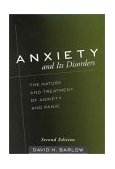Worry: How Much Is Too Much?
Symptoms, causes, treatment of generalized anxiety disorder (GAD) and GAD self-test.
 What is Generalized Anxiety Disorder (GAD) and how do you know if you have it? These questions are not always easy to answer. GAD is the least researched of the anxiety disorders. It was not recognized as a separate disorder until 1980, when the third edition of the Diagnostic and Statistical Manual of Mental Disorders (DSM-III) - the classification guide used by mental health professionals - was published by the American Psychiatric Association.
What is Generalized Anxiety Disorder (GAD) and how do you know if you have it? These questions are not always easy to answer. GAD is the least researched of the anxiety disorders. It was not recognized as a separate disorder until 1980, when the third edition of the Diagnostic and Statistical Manual of Mental Disorders (DSM-III) - the classification guide used by mental health professionals - was published by the American Psychiatric Association.
There are a number of reasons for GAD having gone unrecognized for so long. First, many of the symptoms of GAD overlap with the symptoms of other anxiety disorders. Second, the physical symptoms of GAD mimic those of several medical conditions, often making it difficult to diagnose. Third, GAD tends to have a high rate of comorbidity - meaning that it can occur with other anxiety disorders as well as with depressive disorders.
The identifying characteristic of GAD is excessive uncontrollable worry that affects daily functioning and can cause physical symptoms. The sufferer worries everyday, sometimes all day, to the point where it feels as though the worry has taken over. Worrying takes so much time and energy that it can be difficult to concentrate on anything else. The focus of GAD worry can shift, but usually centers on issues like job, finances, and the health of both self and family. It can also include more mundane issues such as chores, car repairs, and being late for appointments. Although the concerns may be realistic, a person with GAD will spin worry completely out of proportion. The National Comorbidity Survey, a study of the prevalence of psychiatric disorders carried out in the United States in the early 1990's, reported that one half of the people surveyed who had GAD said that it significantly interfered with their life and activities. Two thirds of the people interviewed sought the help of a professional.
Approximately 4 million Americans between the ages 18-54 have GAD, and women are twice as likely to have the disorder. People of either sex who are divorced, don't work outside of the home (homemakers and retirees, for example), or who live in the Northeast also appear to be more vulnerable to developing GAD. Income, race education and religion, on the other hand, do not seem to play a role in who develops the disorder.
What Is Worry?
Worry, also called "What if..." thinking, is pervasive in GAD. Thoughts such as, "What if I am late for the interview? "What if I don't do well on my math test?" constantly run through the mind of the GAD sufferer. To some degree, this type of thinking is a normal reaction to life - everyone has worries and concerns. Worry can even be beneficial. It can help people identify and cope with threats, and it can lead to problem solving. People with GAD, however, cannot control their worrisome thoughts. They cannot help but think about multiple negative outcomes, none of which are likely to occur, while making no attempt to cope with their concerns. A student worried about a final exam, for example, may be motivated to study. Someone with GAD, however, may be so fearful of doing poorly on an exam that he/she can only concentrate his concern, essentially becoming paralyzed worry rather than motivated by it.
 David Barlow, Ph.D., director of the Center for Anxiety and Related Disorders at Boston University, and the author of Anxiety and its Disorders: The Nature and Treatment of Anxiety and Panic, notes that since worry is common to all anxiety disorders, GAD may be the most basic anxiety disorder and that understanding it may lead to a better understanding of anxiety disorders in general. Unlike other anxiety disorders, in which the worries tend to be specific, such as the panic disorder sufferer worrying about having a panic attack, worry in GAD is more general, as the name of the disorder suggests. Individuals with GAD have even been known to worry about worrying, the term for this is "meta-worry."
David Barlow, Ph.D., director of the Center for Anxiety and Related Disorders at Boston University, and the author of Anxiety and its Disorders: The Nature and Treatment of Anxiety and Panic, notes that since worry is common to all anxiety disorders, GAD may be the most basic anxiety disorder and that understanding it may lead to a better understanding of anxiety disorders in general. Unlike other anxiety disorders, in which the worries tend to be specific, such as the panic disorder sufferer worrying about having a panic attack, worry in GAD is more general, as the name of the disorder suggests. Individuals with GAD have even been known to worry about worrying, the term for this is "meta-worry."
Symptoms and Diagnosis
In order for a diagnosis of GAD to be made a person must experience excessive, uncontrollable worry about several issues for more days than not for at least six months. The worry must be accompanied by at least three of the following symptoms:
-
restlessness, or feeling "edgy"
-
being easily tired
-
difficulty concentrating
-
irritability
-
muscle tension
-
difficulty sleeping
The physical symptoms of GAD, which can include chest pains and irritable bowel syndrome, often prompt sufferers to see their primary care physicians. These physical symptoms are often treated first, which delays diagnosis of GAD. Another reason GAD may not be immediately recognized as an anxiety disorder is because it lacks some of the dramatic symptoms that are seen with other anxiety disorders, such as unprovoked panic attacks.
Onset of GAD can occur in childhood, but a stressful event, such as having a child, can also trigger the disorder later in life. The age of the person with GAD has been shown to have an impact on what the person worries about. Young children tend to worry about their physical well-being and safety, while older children are more concerned with their psychological well-being and overall competence. Adults over 65 reported worrying about becoming burdensome to their families, as well as having more health related worries than did adults between the ages 25-44.
Treatment
An important step in the treatment of any anxiety disorder is learning about and understanding the disorder. This gives the patient a certain amount of control over their symptoms and it also helps them realize that others have had similar experiences. It is also very important to be able to make informed decisions about treatment. There are a variety of treatment options available for GAD, and more are currently being researched.
Medication is sometimes indicated in the treatment of anxiety disorders and has been proven effective in reducing the symptoms of anxiety. It can be especially effective when there is more than one anxiety disorder or when there is comorbid depression, as is often the case with GAD. The alleviation of anxiety symptoms can allow the patient to move forward with psychosocial therapies, which can work well in combination with medication.
Several psychosocial techniques have been proven effective in the treatment of anxiety disorders. Various techniques, known collectively as Cognitive Behavioral Therapy (CBT), have been shown to work well for GAD in particular, some of these techniques are: self-monitoring, cognitive therapy, and worry exposure.
Self-monitoring - the principle behind this technique is that the patient takes note of when he/she begins to feel anxious and records when and where the feelings began, their intensity and the symptoms. The goal is for the individual to become familiar with the patterns of his/her anxiety and worry.
Cognitive therapy - works to help the patient change his/her thought patterns. The goal here is the reappraisal of worry, leading the patient to think more realistically about his/her worry and negative thoughts. This includes changing thoughts that may actually promote worry, such as, "If I worry about it, it won't happen."
Worry exposure - requires that patients expose themselves to situations and ideas that worry them in order for them to both become used to the worry, and so that they can see that worrying and anxiety do not cause negative events.
With so many treatment options available, it is necessary that treatment be specially tailored to each individual. The best way to go about this is to see a mental health professional who specializes in the treatment of anxiety disorders.
APA Reference
Staff, H.
(2002, September 1). Worry: How Much Is Too Much?, HealthyPlace. Retrieved
on 2025, November 28 from https://www.healthyplace.com/anxiety-panic/articles/worry-how-much-is-too-much



